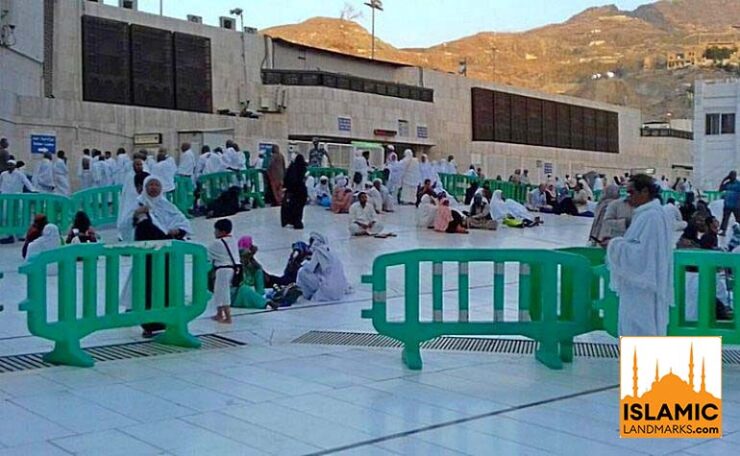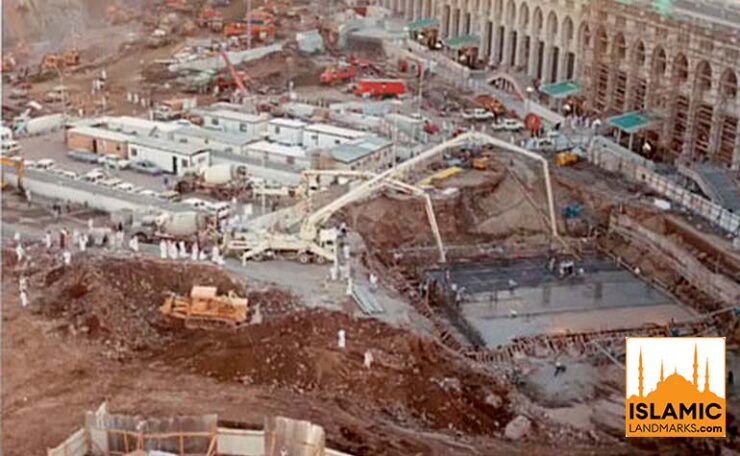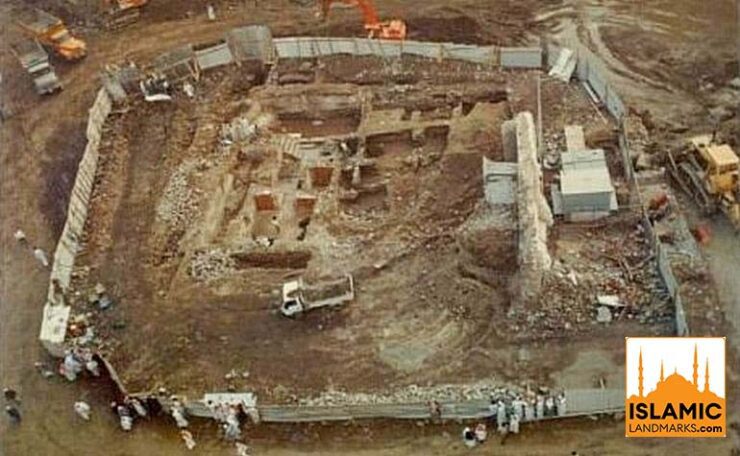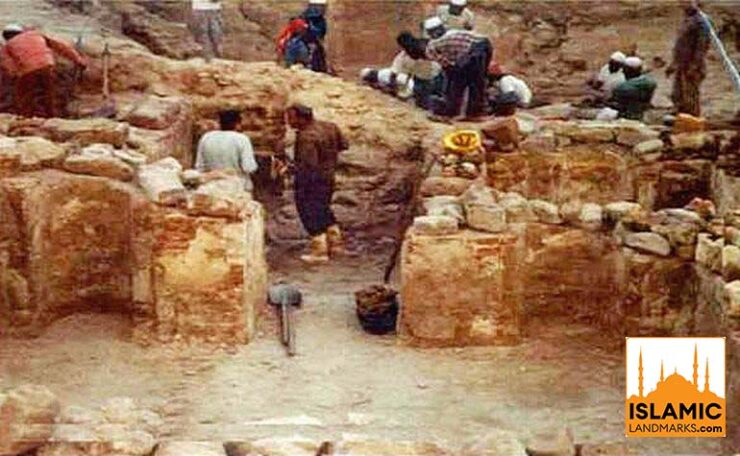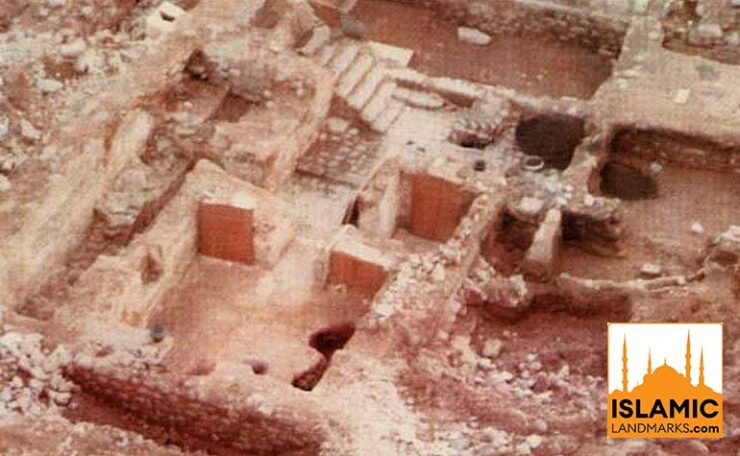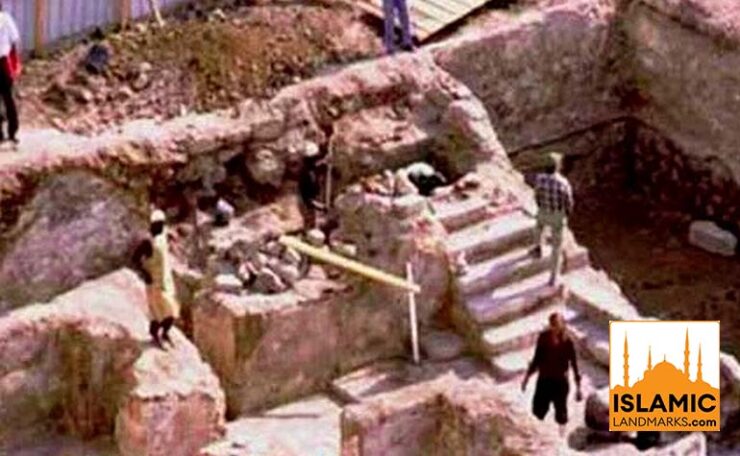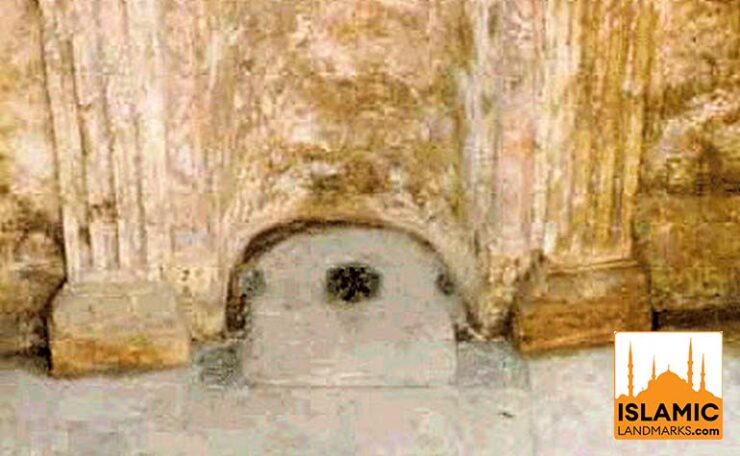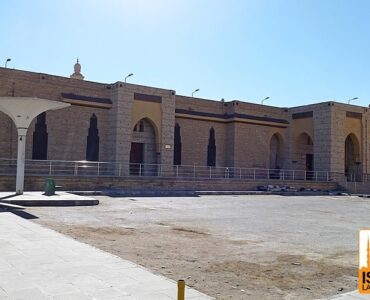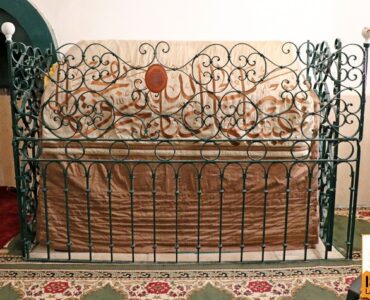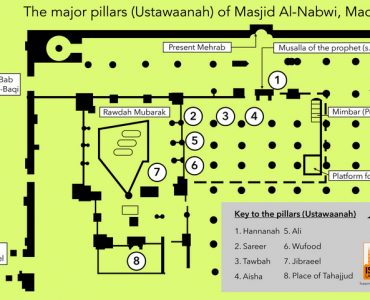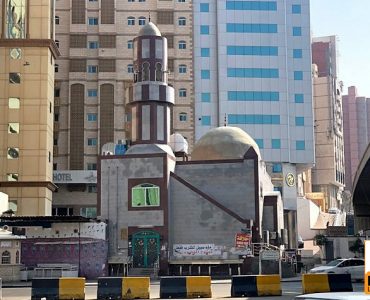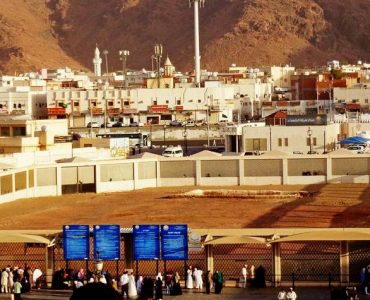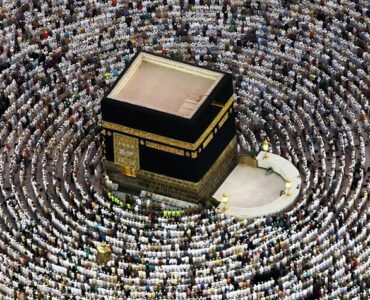This is the approximate region, outside the Marwah exit, under which the house of Ummul Mu’mineen Khadija (رضي الله عنها) was located. It was here that the Prophet (ﷺ) lived from the time of his marriage to her until he emigrated to Madinah.
Marriage of the Prophet (ﷺ) to Khadija (رضي الله عنها)
- When the Prophet (ﷺ) married Khadija (رضي الله عنها), he moved out from the house of his uncle Abu Talib and into the house of his bride. At the time of their marriage he (ﷺ) was 25 and Khadija (رضي الله عنها) was 40 years old. They stayed together for 25 years.
- Khadija’s (رضي الله عنها) full name was Khadija bint Khuwaylid ibn Asad ibn ‘Abd al-‘Uzza ibn Qusayy. She was the Prophet’s (ﷺ) first wife, he married none other during her lifetime.
- She bore all his children except for Ebrahim, who was born to Mariya Qibtiya (Mary the Copt). All of the children were born at her home. They were named (in order of birth) Qasim, Zaynab, Ruqayyah, Umm Kulthoom, Fatima, Abdullah, and Ebrahim (scholars, however, disagree about the exact number and order of births). All the sons passed away during childhood, but all the daughters lived to see their father become a prophet. Each daughter embraced Islam and migrated to Madinah, and all but Fatima (رضي الله عنها) died during the lifetime of the Prophet (ﷺ). Fatima (رضي الله عنها) died six months after her father’s death.
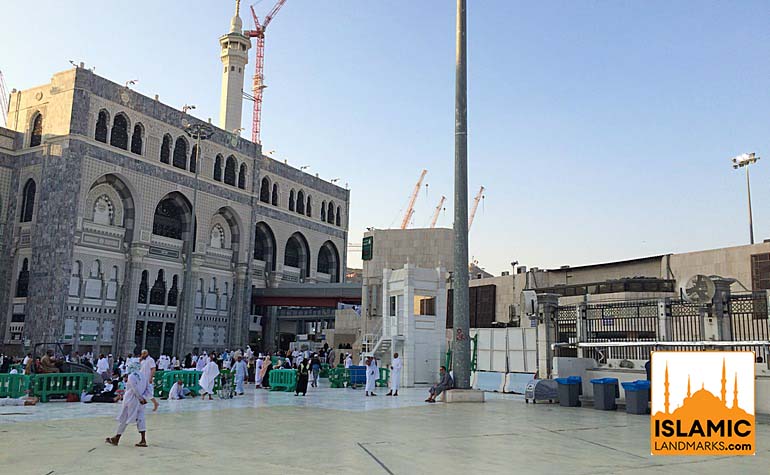

Other members of the household
- As well as their immediate family, the Prophet (ﷺ) and Khadija (رضي الله عنها) also had extended members of their household. Barakah (who later became more commonly known as Umm Ayman), was the freed African slave the Prophet (ﷺ) inherited from his father and whom he would sometimes affectionately address as ‘mother’. Zaid bin Haritha was a slave boy given as a bridal gift to the Prophet (ﷺ) by Khadija (رضي الله عنها). He was set free by the Prophet (ﷺ) but Zaid chose to stay with him and became an adopted son. The Prophet (ﷺ) also took his cousin Ali into his household on account of the financial hardships his uncle Abu Talib was experiencing.
Significance of this house
- In this house, Khadija (رضي الله عنها) became the first person to accept Islam. It was here too that Zaid bin Haritha (رضي الله عنه), the freed slave of Khadījah, joined the religion, as did Ali bin Abi Talib (رضي الله عنه), who grew up in the house.
- The house saw the beginnings of the message carried by the Prophet (ﷺ). Here Jibraeel (عليه السلام) brought down the revelations of the Quran on several occasions. The spot in the house where he used to descend was subsequently known as the Dome of Revelation.
Location of the house
- Contrary to popular belief, the house was not located where the toilets are outside the Mount Marwah exit. This graphic shows the approximate location:
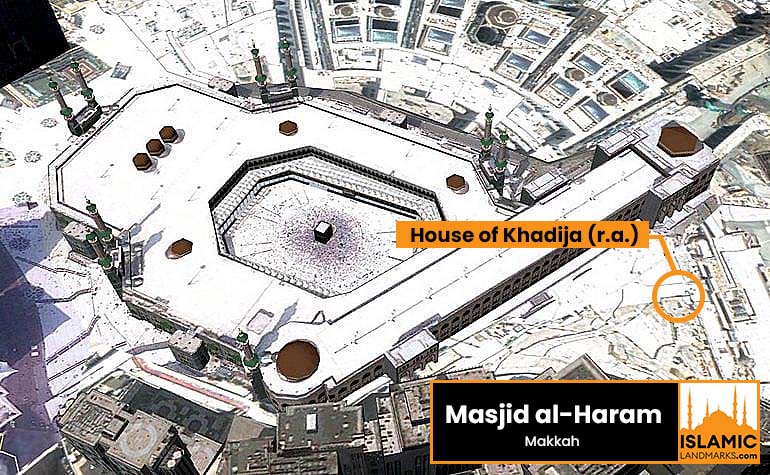

The support of Khadija (رضي الله عنها)
- When the Prophet (ﷺ) received the first revelation of the Quran on Mount Hira he came back home and said to Khadija (رضي الله عنها), “Wrap me up, wrap me up.” Khadija (رضي الله عنها) wrapped him up in a blanket. When he (ﷺ) regained peace of mind after a short while, he related to Khadija (رضي الله عنها) what had happened to him with the remark, “I feel my life threatened.” Khadija (رضي الله عنها) replied, “By no means, I swear to Allah that He would never put you to shame. You join the ties of relationship, you speak the truth, you bear people’s burdens, you help the destitute, you entertain guests and you mitigate the pains and grief suffered for the sake of truth.” She unhesitatingly believed in him, and accepted Islam immediately.
- The boycott of the Muslims in She’eb Abi Talib took a heavy toll on the health of Khadija (رضي الله عنها), and shortly after it was ended she passed away. She was the Prophet’s trusted advisor and loyal companion, and was known by the title ‘Mother of the believers’. The Prophet (ﷺ) once said of Khadija (رضي الله عنها), “When no one believed me, she believed in me, when people accused me of lying, she affirmed my truthfulness, and when people tried to impoverish me, she made me a partner in her wealth.”
The Prophet (ﷺ) escapes an assassination attempt at his house
- When the idolaters of Makkah plotted to assassinate the Prophet (ﷺ) they surrounded his house at night. Inside was the Prophet (ﷺ) along with Ali (رضي الله عنه). The Prophet (ﷺ) told Ali (رضي الله عنه) to sleep in his bed and cover himself with his green garment and assured him full security under Allah’s protection and that no harm would come to him. He (ﷺ) then came out of his house and cast a handful of dust on the assassins and managed to work his way through them reciting these verses of the Quran: “And We have put a barrier before them, and a barrier behind them, and We have covered them up, so that they cannot see.” [36:9]
- The Prophet (ﷺ) made his way to the house of Abu Bakr (رضي الله عنه) from where they set off on the Hijrah to Madinah. Unaware of the Prophet’s escape, the would-be assassins waited for him to come out of his house. Only at dawn when Ali (رضي الله عنه) awoke and came out did they realise that they had been tricked. They interrogated him about the Prophet’s whereabouts, but he pleaded ignorance. They then dragged him to the Ka’bah and kept him captive there, but he divulged nothing.
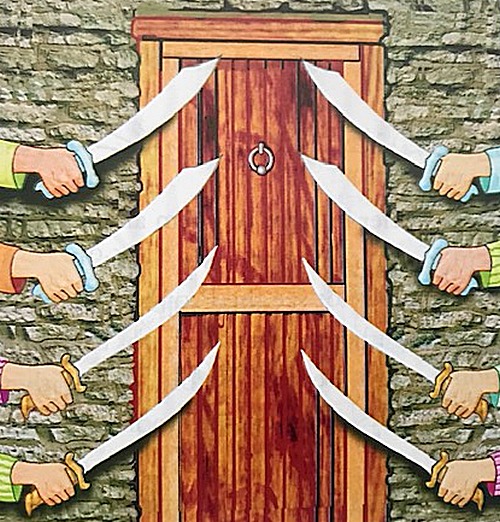

What became of the house?
- The Prophet (ﷺ) had stayed in the house of Khadija (رضي الله عنها) for around 28-29 years.
- Mu’attab bin Abi Lahab confiscated the house after the Prophet (ﷺ) emigrated to Madinah. He retained the house in his possession even after the Prophet (ﷺ) later returned to Makkah. Mu’attab eventually accepted Islam.
- Muawiyyah bin Abi Sufyan (رضي الله عنه) purchased the home for a sum of 100,000 dirhams from Mu’attab during his reign as caliph from 661 to 680 CE.
- The property that Muawiyyah (رضي الله عنه) had inherited from his father was just west of Khadijah’s (رضي الله عنها) home, making it possible for him to connect the home to that of his deceased father by means of a door that he created in the wall that faced his father’s home. He then constructed a connected mosque that extended west and northwest from the new door to encompass the space between the two homes along with large portions of the southeastern part of his father’s property.
- Other than the creation of this door, Muawiyyah (رضي الله عنه) took great care not to change anything about Khadijah’s (رضي الله عنها) home, marking its borders and preserving the original structure, foundations, and layout.
Layout of the house
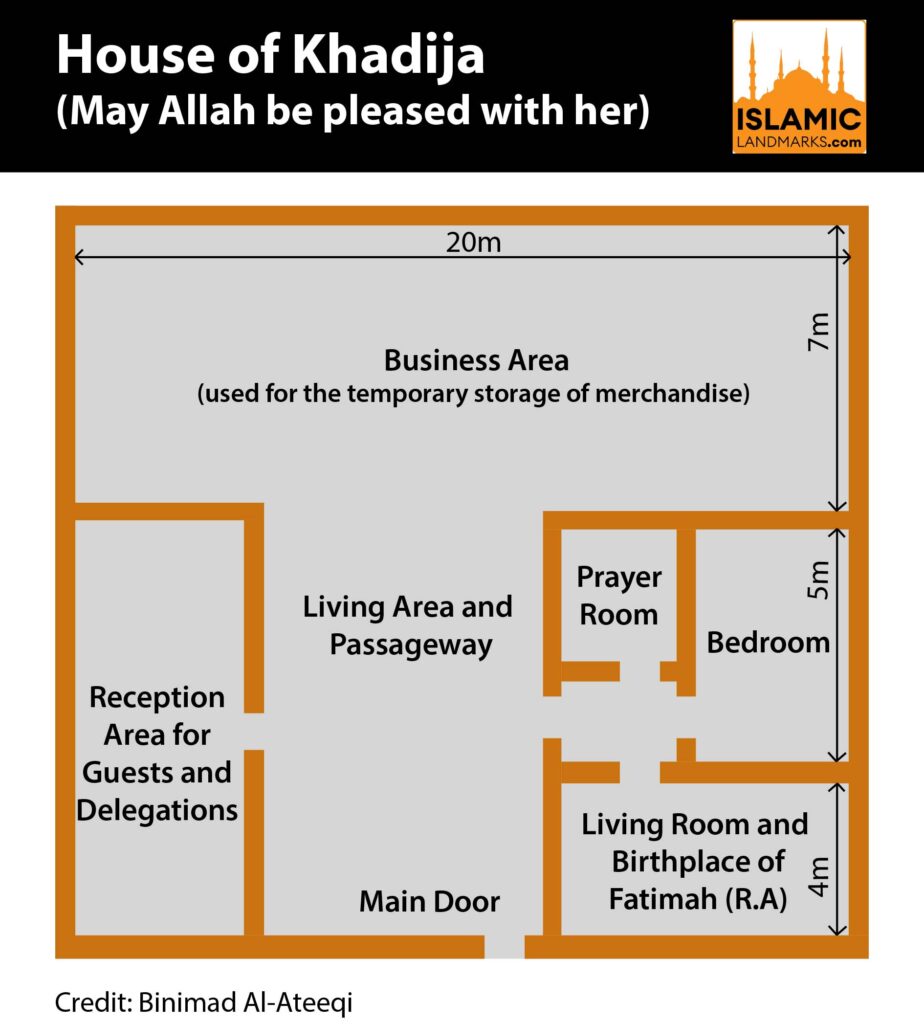

- In the new mosque, those who wished to do so could enter Khadijah’s (رضي الله عنها) home and pray inside of the Prophet’s (ﷺ) personal prayer room, where he had received revelations of the Quran. They could also visit the room in which Fatima (رضي الله عنها) had been born and see the room in which the Prophet (ﷺ) had taken cover from the stones that were hurled at him by oppressive idol-worshiping neighbours, including his uncle Abu Lahab.
- Over the centuries there were a lot of changes in the area, in particular the elevation of the ground level after years of floods carrying and depositing mud.
- In 1885, Christiaan Snouck Hurgronje, the Dutch Orientalist, visited the house. He noted that both the house of Khadija (رضي الله عنها) and the Birthplace of the Prophet (ﷺ) were below ground level. He also recorded that officials of that time were charging a fee to those visiting the house of Khadija (رضي الله عنها).
- The last major preservation of the home was undertaken by the last Ottoman Caliph, Sultan Abd al-Majid in around 1923.
- The Egyptian writer Mohammad Labib al-Batnuni visited the site in 1908/9, writing a detailed and preserved description of the house. The above floorplan is based on the sketches he and others carried out:
The Sayyid Abbas School
- By 1950, the house did not exist any more. An Egyptian lawyer, Muhammad Lutfi Jum’ah, travelled to Makkah and noted that what was left was an empty patch of land. The walls had been removed and the foundation covered with sand. Under pressure from key religious figures of the time, the new Saudi government had levelled the house (and other significant historical sites) out of fear that people would make them a source of exaggerated veneration.
- However, Shaykh Abbas Yusuf Qattan, the Mayor of Makkah at the time was alarmed by these developments and succeeded in obtaining a legal document that granted him control over the site. He preserved the site in a discreet fashion by concealing the home under layers of soft sand and building a school for the memorisation of the Quran on top. This was named the Sayyid Abbas School.
- He also had a small library built over the Birthplace of the Prophet (ﷺ).
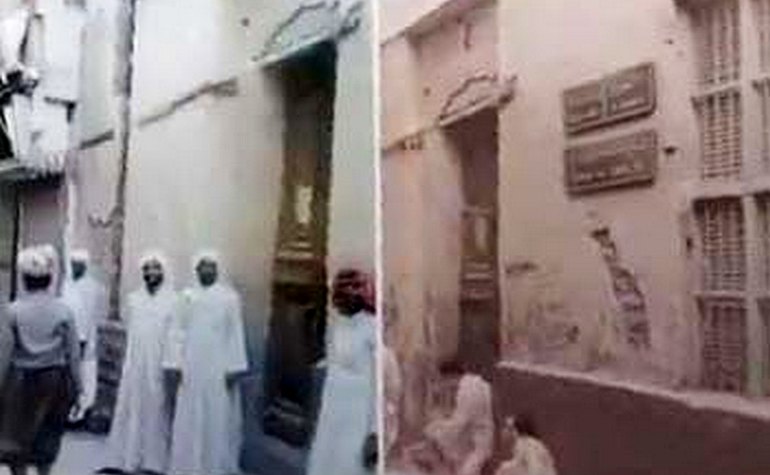

Expansion of Masjid al-Haram
- In 1989, a project was initiated to expand the area outside the Mas’aa to accommodate the increasing number of pilgrims to the Masjid al-Haram. This involved clearing the area where the school stood over the original house of Khadija (رضي الله عنها).
- In order to preserve aspects of the site, an archaeological excavation was carried out under the school from the end of November to the end of December 1989. Detailed recordings and photographs were made and analysed to establish what belonged to the original house of Khadija (رضي الله عنها) and what was actually part of the mosque later constructed by Muawiyyah (رضي الله عنه).
- After the documentation process a decision was made to cover the entire site with a special soft sand, which was free from any salinity or impurities. Today, the spot is part of the women’s prayer area near the exit of Mount Marwa (see main photo above).
Photos from the 1989 excavation work
- Click on the images to enlarge
References: Local Makkan guide, When the Moon Split – Shaikh Safiur-Rahman Mubarakpuri, The Sealed Nectar – Shaikh Safiur-Rahman Mubarakpuri, Muhammad – Martin Lings, Makkah at the time of Prophet Muhammad (PBUH) – BinImad Al-Ateeqi

